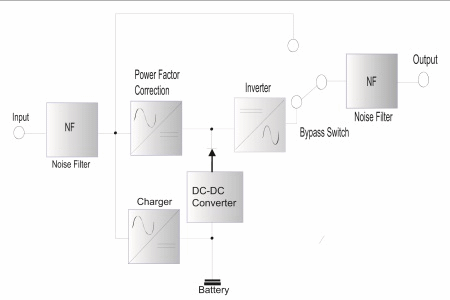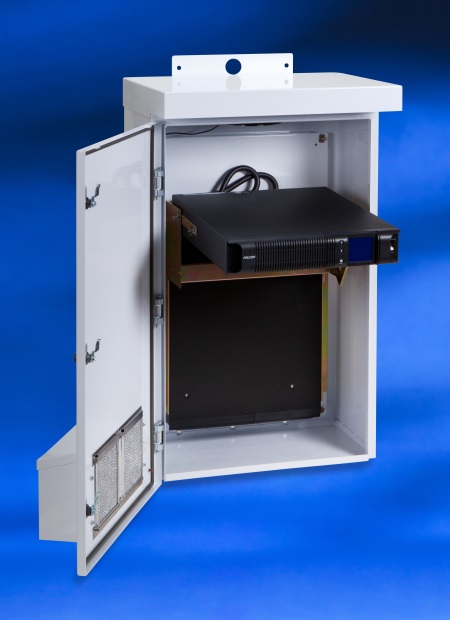BY MICHAEL A. STOUT
Vice President Engineering
Falcon Electric
When most of us think about an uninterruptible power supply (UPS), the little box we have connected to our home or office workstation comes to mind. It sits there faithfully doing its job day after day, and we only notice it when it beeps while providing backup power, preventing the loss of our work. For some, the loss of work is a minor inconvenience, but for others it means recreating hours or even days of work. The UPS used in these applications is typically very low cost and low tech, providing the limited functions of battery backup and surge protection. In a controlled office environment, this may be all that is needed. The UPSs used for this application are referred to as off-line or line-interactive, which designates their design topology. In these types of UPS models, utility power passes directly through the UPS, with their inverters operating only when utility power has been lost — and they are operating from their internal batteries.
However, for a company’s server room, UPS requirements are a bit more demanding. The company’s data, communications and productivity are on the line. Servers, network infrastructure, Internet, and telecommunications must be protected with a higher level of reliability. Due to the amount of interconnectivity culminating in the server room, a UPS is required that offers a higher level of power protection in addition to battery backup. A mid-priced double-conversion online UPS is ideal for this higher-level application. The online UPS (see Fig. 1 ) regenerates clean, regulated power when operating from utility and battery. The online UPS eliminates many more kinds of power anomalies, providing a much more stable power source to the server room equipment. As with the off-line and line-interactive UPS, The majority of the online UPS products on the market have been designed to be installed in a protected and temperature-controlled environment.

Fig. 1: Online UPS diagram
But not all UPSs are located in a protected office or server room environment. An ever exploding number of industrial applications are so demanding that the UPS industry has started to offer online UPSs having a much more robust design. They are referred to as an industrial-grade or wide-temperature-range online UPS. Office or server-level UPS products are typically rated for use in a 0° to 40°C operational temperature environment. However, the wide-temperature-range UPS may have a –32 ⁰ to 65 ⁰ C operational temperature specification. This class of UPS is not weather-proof and must be protected in an indoor location or in a properly rated NEMA-type enclosure. Yet its wide operational temperature range, tied with its high level of power conditioning and protection, makes the online UPS the ideal solution for harsh environments.
One such application subjected to temperature extremes is in the oil and gas industry. Oil and gas are under great pressure at the well head. To control the flow, a motor operated valve (MOV) is installed at the well head and controlled by a system control and data acquisition system (SCADA). The control of the MOV is critical as it must always be secured in a closed position should the SCADA system detect any abnormality at the well head site. Due to the remote locations of well heads, power outages are very common. A loss of power would result in the MOV being left in an open state and the oil flow left uncontrolled. The ramifications of an uncontrolled MOV could range from a costly oil spill cleanup to the total loss of the well. To protect against this problem, a UPS is incorporated into the SCADA system and MOV control. In addition to MOV control, the SCADA system monitors the well head pressure, controls onsite ground water and oil separation, monitors various containment tank levels and acquires critical data from various site sensors. It continuously communicates the site status in real-time to a central monitoring location via a wireless transceiver. UPS backup power is essential to all of these operations. Yet, due to the remote location of the site, providing a temperature controlled environment is far too costly. A wide-temperature-range online UPS provides a very high level of protection against power-quality problems while supplying ideal power to the site’s SCADA equipment over the entire range of seasonal temperature extremes.
Another application subjected to harsh environments is toll roads. Through the distribution of small transponders linked electronically to their respective user’s credit or ATM account and fixed Radio Frequency Identification (RFID) transceivers located at toll collection points, toll road computing systems are dependent on clean, continuous power. Long gone are the “old school” toll booth bottlenecks thanks to RFID transceivers and automated number plate recognition (ANPR) systems that read vehicle license plates and checks a database for a valid or invalid user’s status. If the transponder number and license plate number agree, the user is billed. In the event of a loss of utility power, all of this equipment must be powered for up to seventy-two hours. The support electronics and UPSs are housed in NEMA 3R enclosures (see Fig. 2 ) stationed on the side of the freeway, adjacent to the toll collection facilities; they are subject to the same seasonal temperature extremes of the oil field application. Again, a wide-temperature-range UPS is essential to system reliability and profitability.

Fig. 2: Falcon Electric SSG series double-conversion UPS in NEMA-rated enclosure are UL, cUL, and CE-Listed to operate between –20° and 55°C and – 30° and 65°C .
As the wide-temperature-range UPS market is relatively new, care must be used when purchasing a UPS stating wide-temperature capabilities. Due to the critical and unique challenges present when installing an online UPS in a wide-temperature application, the importance of the UPS manufacturer receiving a safety agency approval such as a UL Listing mark is a vital consideration. A review of the manufacturer’s product specification with respect to operating temperature range and safety agency listing status is essential as not all manufacturers stating wide-temperature product specifications have submitted their products to an approved safety agency like UL or ETL for evaluation at the stated wide temperature range and subsequent listing mark.
Advertisement
Learn more about Falcon Electric





